$KDP (-0,13 %)
$7751 (+0,78 %)
$NXPI (-1,64 %)
$WM (+2,8 %)
$CDNS (-3,82 %)
$BN (+0,62 %)
$SOFI (+0,22 %)
$UNH (+1,45 %)
$AMT (-1 %)
$UPS (+1,06 %)
$BNP (-0,85 %)
$NVS (-0,22 %)
$DB1 (-0,37 %)
$MSCI (+1,92 %)
$ENPH (-3,08 %)
$BKNG (+0,42 %)
$LOGN (-6,19 %)
$V (+0,4 %)
$MDLZ (+0,94 %)
$PYPL (-0,02 %)
$000660
$MBG (+0,33 %)
$BAS (+0,71 %)
$UBSG (+1,17 %)
$SAN (-1,62 %)
$CVS (+0,07 %)
$OTLY (-1,69 %)
$GSK (-0,02 %)
$ETSY (+0,66 %)
$CAT (-3,04 %)
$KHC (+0,29 %)
$ADYEN (+0,17 %)
$ADS (+1,99 %)
$AIR (+0,1 %)
$SBUX (+0,58 %)
$CMG (+3,32 %)
$META (-1,55 %)
$KLAC (-4,84 %)
$MELI (-0,2 %)
$WOLF (-6,19 %)
$GOOGL (-3,46 %)
$EQIX (-0,76 %)
$MSFT (-0,32 %)
$CVNA (-3,57 %)
$EBAY (+1,37 %)
$005930
$6752 (+4,32 %)
$KOG (+0,28 %)
$VOW3 (+0,93 %)
$GLE (-0,31 %)
$LHA (+4,2 %)
$STLAM (-0,39 %)
$SPGI (+0,57 %)
$MA (+1,21 %)
$PUM (+3,13 %)
$AIXA (-4,16 %)
$FSLR (-6,51 %)
$AAPL (-0,42 %)
$REDDIT (+0 %)
$AMZN (-2,35 %)
$NET (-3,02 %)
$MSTR (-4,52 %)
$GDDY (-0,93 %)
$TWLO (-1,36 %)
$COIN (-1,25 %)
$066570
$CL (-0,04 %)
$ABBV (-1,35 %)
$XOM (-1,06 %)
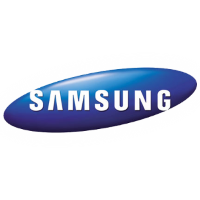
Samsung Electronics
Price
Discussion sur 005930
Postes
37Quarterly figures 27.10-31.10.25
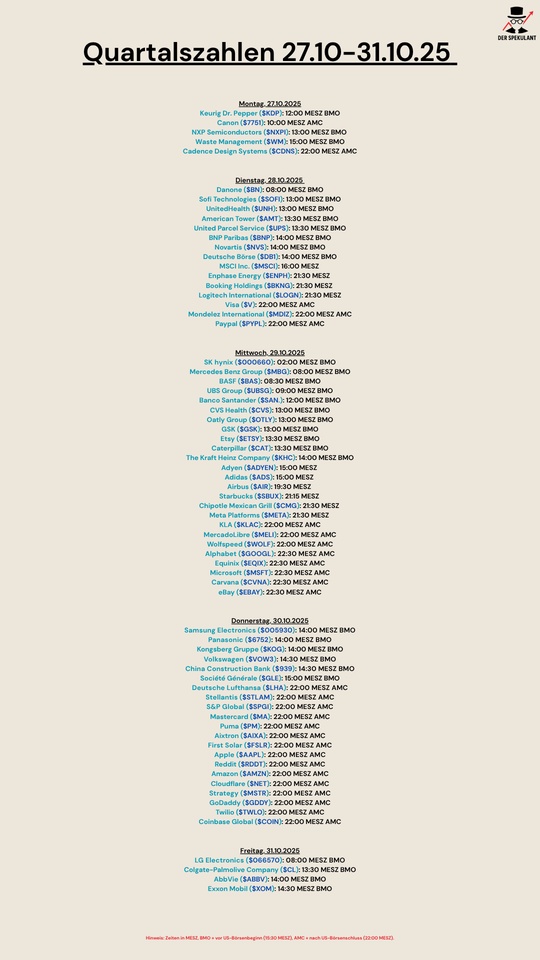


Samsung and Telekom want to abolish smartcards
At it-sa, Samsung $005930, Nexus $NEXUS (-7,13 %) and Deutsche Telekom $DTE (-0,8 %) presented a joint solution with which the smartphone could replace the smart card for access and identity checks in companies and public authorities.
Samsung has been offering security functions for its mobile devices under the brand name Knox for many years. Samsung Knox Native is the security-hardened foundation of all enterprise functions on Samsung devices - a combination of hardware, firmware and OS layers designed to guarantee device integrity, data protection and enterprise management.
Together with Deutsche Telekom Security and PKI specialist Nexus, Samsung has now presented a new mobile access solution based on this foundation at it-sa. It is designed to "turn the smartphone into a secure digital ID card for access and identity checks" - or in other words, it could replace the smart card in many cases.
The starting point for this was the need in public authorities, which often work with a smart card as an authentication method - even when accessing computers or company resources. The new offer brings the smartcard virtually into the smartphone and also allows the functions known from the smartcard (such as additional protection via a PIN) to be mapped.
"The more mobile devices are used for business-critical tasks, the stronger the protective measures that authorities and companies should take to ensure the security of these devices," says Tuncay Sandikci, Director MX B2B at Samsung.
Samsung Knox Native contributes to "keeping digital identities protected and reliable on the smartphone."
The joint development with Nexus and Deutsche Telekom Security has struck a good balance between security and usability, Sandikci emphasized to ChannelPartner at it-sa 2025. The offering is currently being tested with some partners in proof-of-concepts. The market launch will then take place gradually in the first half of 2026.
The partners primarily want to score points in the government business. However, there is no reason why it should not also be sold to corporate customers with high security requirements - or simply those who want to consolidate several authentication methods into one. After all, the providers believe that there is nothing to stop it being used for billing in the canteen, for example, or together with concepts for follow-me printing.
Samsung and Telekom are relying on their proven channels for distribution. This means that Telekom business partners will be able to sell the offer. However, participants in the Samsung Business Partner Program will also have access to it. "Sandikci intends to make it available both to partners who market the Knox Suite for lifecycle management and to those who manage devices for customers as Knox MSPs.
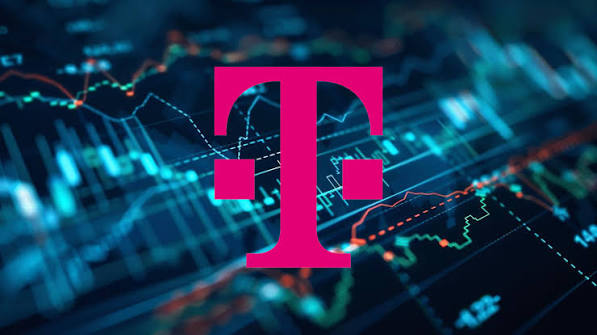
Is the AI bubble really bursting...?
I've just read an article in Die Welt about $005930 I'll just take note of it for now, but will gladly leave it to the community for discussion.
"Then the bubble bursts" - the delicate consequences of the Samsung discovery
A new AI model from Samsung requires 10,000 times less power than current competitor series such as GPT or Gemini. This discovery, which has now been published, jeopardizes the hundreds of billions invested by Nvidia, Microsoft Google & Co and could prove to be a gigantic AI trap.
Wild deals in the AI sector have dominated the stock market news in recent weeks: Nvidia sold supercomputers worth 100 billion dollars to ChatGPT startup OpenAI in early September, gets shares in OpenAI in return. AMD concluded a similar shares-for-chips deal at the beginning of October, and its share price promptly shot up too. Whoever announces the largest data center supercomputer deal wins.
The stock market rewards AI companies for investing hundreds of billions of dollars in capital goods with a finite expiry date. But what if the investments in supercomputers were not necessary at all - if the same artificial intelligence could be developed with much less computing power?
This is the question posed by Alexia Jolicoeur-Martineau, Senior Researcher for Artificial Intelligence at Samsung's Advanced Institute of Technology in Montreal, Canada. This week, under the heading "Less is more", she published a self-developed artificial intelligence that uses just seven million parameters and is therefore ten thousand times smaller than the competing models from OpenAI, Google and other competitors. Nevertheless, according to its inventors, this mini AI outperforms state-of-the-art language models, including Google's current Gemini 2.5 or OpenAI's o3-mini, in some of the most difficult reasoning benchmarks in AI research.
The Samsung model breaks new ground - it first develops an approximate solution for a logic task, then works in repetitive loops to optimize the solution - and requires significantly less computing power than the competition. Samsung has published the program as open source software, and AI researchers from the competition can see for themselves that it works.
"The idea that you have to rely on massive base models trained by large companies for millions of dollars to solve difficult tasks is a trap," wrote Jolicoeur-Martineau on the social network X. "Currently, there is too much focus on using large language models instead of developing and expanding new directions
Whether the Samsung approach actually represents a revolution in the research of current thought models and whether it will stand up outside a relatively narrow circle of benchmark tests has not yet been tested by independent experts.
However, this does not change the fact that researcher Jolicoeur-Martineau is challenging the current AI boom with a fundamental question: What if a technological breakthrough in AI software were to suddenly devalue the billions invested in hardware?
What if the accumulation of more and more power-hungry AI chips is actually a mistake, if it is not the large LLM models but combinations of much smaller, specialized models that win the race for general artificial intelligence? Then the billion-dollar data centers full of Nvidia chips would be worth significantly less in one fell swoop - and the most important companies in the AI boom might have to be revalued.
The performance of the OpenAI model GPT 5 published a few weeks ago already shows that the marginal benefit of the training computing time used is currently decreasing significantly: Although the large language models are getting better and better, the time of big leaps in performance by bluntly using more and more computing power is over for the time being.
The next big advance is missing. If this really is based on the motto "less is more", then the billions planned to be invested in the coming years would be called into question and the data centers that have been built so far could be written off much faster than their builders had planned and hoped.
Unlike previous capital-intensive technical revolutions, unlike the fiber optic boom of the early 2000s or railroad construction from 1840 onwards, the investments made are only of a fleeting nature. Fiber optics in the ground remain valuable. Data centers without supercomputers, however, are little more than well-cooled industrial halls with very large power connections.
However, the supercomputers themselves, which account for around 60 percent of construction costs, have a half-life of just three years and are currently replaced after five to six years, as their high power consumption makes continued operation unprofitable. They have to recoup their construction costs within a very short time before they become worthless. The "Summit" supercomputer used by the US Department of Energy, for example, was the fastest computer in the world when it was commissioned in June 2018 thanks to its Nvidia chips. It was only operated until November 2024, after which it became obsolete
With their development, the Samsung researchers are not only questioning the current large models of the competition. They are indirectly questioning the entire current AI boom on Wall Street, which is primarily based on chip deals and the bartering of supercomputers for computing time. If the technology continues to advance as fast as it has so far, many investors, infrastructure companies and data center operators could be left with billions of dollars in investment ruins within a short space of time.
"In order to refinance the announced investments, ten new AI companies of the size and with the turnover of Google would have to grow up within a short period of time. I think that's unrealistic," says Damian Borth, AI researcher at the University of St. Gallen. Part of the basic work on small models, which the Samsung researchers are now building on, was carried out at his institute.
Borth has been observing for several months that "the neural scaling laws are becoming saturated" - in other words, that the rule that more and more computing power always results in more intelligent models is no longer valid.
"Light weight models, i.e. AI models that require significantly fewer parameters, are currently the most important trend in the industry," explains Borth. The trend was partly born out of technical requirements - models should run on smartphones alone - and partly out of necessity: Only relatively few researchers have access to enough computing time on supercomputers to train large models. This current research direction is now determining progress towards general artificial intelligence, the holy grail of AI research.
Borth therefore sees a discrepancy between market expectations of ever-increasing expenditure on AI infrastructure and current research: "The question is: do we even need such large models, so many parameters, to solve the majority of AI tasks? If not, then we don't need so many supercomputers."
However, Borth believes that as long as the big AI companies continue to uphold the vision of general artificial intelligence from supercomputers, which is set to arrive in the near future, the boom in data centers will continue to be financed. "This is a matter of national security alone - the US cannot afford to lose this race." But the moment faith in the supercomputer AGI wavers is also the moment when AI stocks on the stock market have to be harshly revalued. "Then the bubble bursts," says Borth. The AI model from Montreal could be the first pinprick in the bubble, with more likely to follow.
=> Bursting averted for the time being
The AI chip super alliance: Samsung, SK hynix and OpenAI build the global AI infrastructure
$HY9H (-4,1 %) . $SMSD (-3,85 %)
$005930
$006400
CALIFORNIA, USA (IT-Times) - Samsung Electronics, SK hynix and OpenAI announce new strategic partnerships as part of OpenAI's Stargate initiative.
The goal of the strategic collaboration is to expand the infrastructure critical to AI development globally and in South Korea.
The announcement was made during a meeting between OpenAI CEO Sam Altman and South Korean President Lee Jae Myung in Seoul, as well as top executives from Samsung and SK hynix.
The partnerships will focus on increasing the supply of advanced memory chips needed for next-generation AI and expanding data center capacity in Korea.
This positions Samsung and SK hynix as key players in the global AI infrastructure and supports Korea's ambition to become one of the top three AI nations in the world, a statement said.
Under the agreement, Samsung Electronics and SK hynix plan to increase production of advanced memory chips, according to a statement issued on October 1, 2025.
The goal is to produce 900,000 DRAM wafer starts per month with accelerated capacity expansion, which is critical to delivering OpenAI's advanced AI models.
OpenAI also signed a series of agreements today to explore the development of next-generation AI data centers in Korea.
These include a Memorandum of Understanding (MoU) with the Korean Ministry of Science and ICT (MSIT), specifically to explore opportunities to build AI data centers outside of the Seoul metropolitan area.
The agreements signed today also include a separate partnership with SK Telecom to explore the construction of an AI data center in Korea and an agreement with Samsung C&T, Samsung Heavy Industries and Samsung SDS to explore opportunities for additional data center capacity in the country.
Samsung Electronics and SK hynix will also deploy ChatGPT Enterprise and API capabilities across their organizations to improve workflows and support new forms of innovation.
Huawei's top AI chip reportedly uses components from TSMC, Samsung and SK Hynix
http://www.aastocks.com/en/stocks/news/aafn-con/NOW.1474641/
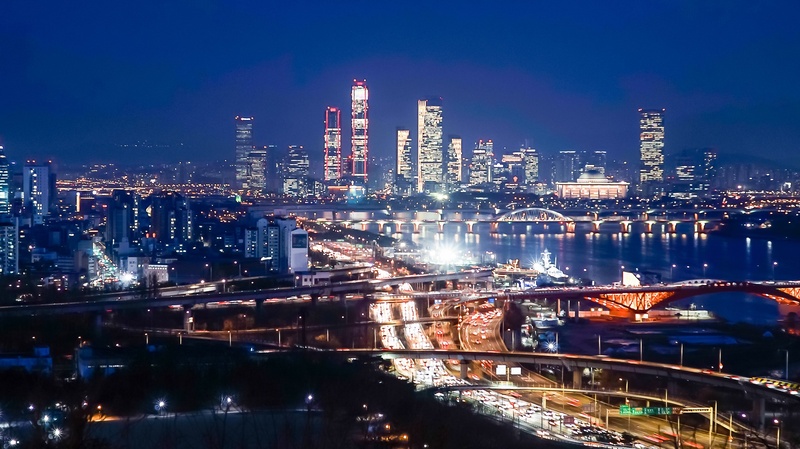
What you can pack into a smartphone for around €700 😁 (most expensive model)
$1810 (-0,59 %)
$AAPL (-0,42 %)
$005930
$1810 (-0,59 %)
Xiaomi has launched its new flagship smartphone series on the market.
The company is skipping a generation and naming the series Xiaomi 17 instead of Xiaomi 16, as expected.
The standard model, the Xiaomi 17, offers significant hardware improvements.
These include a 1G+6P hybrid lens for the rear main camera and a front camera that has been upgraded from 32 MP to 50 MP.
The battery capacity has been significantly increased from 5,400 mAh to 7,000 mAh, with the proportion of silicon anode increasing from 10% to 16%. The display has also been optimized with improved red brightness.
The Xiaomi 17 Pro also has a second display on the back.
This enables the customization of content, serves as a viewfinder for self-portraits and can transform the smartphone into a retro handheld game console in combination with a special case from Xiaomi.
The rear main camera integrates LOFIC HDR technology, which enables improved detail capture in different lighting conditions.
As a new addition to the product line, Xiaomi introduced the 17 Pro Max model. In addition to the features of the Pro model, it offers an improved OLED display with a new RGB arrangement, a larger sensor for the telephoto zoom camera and an even larger battery with 7,500 mAh.
The entry-level price for the Xiaomi 17 is 4,499 yuan, which is the same as the launch price of the Xiaomi 15.
The 17 Pro starts at 4,999 yuan, which is 300 to 500 yuan below the launch price of the Xiaomi 15 Pro, but similar to its current reduced price.
The new 17 Pro Max is available from 5,999 yuan.
With the introduction of the premium Pro Max model, the average selling price (ASP) of the 17 series is around 4% higher than last year's series.
Once again 212
So 1.5 weeks have now passed. The first gimmicks are over and my Watchlist Pie has returned a total of 4.5% in one week. This has now been sold and I have built up a pie to save for the next 8-10 years. I'm starting with 50€ a week until I've completed the broker's test phase. After that I'll ramp it up to about 1k per month.
There are still a few stocks missing, but the big ones will be scaled down a bit. Among others $IREN (-9,32 %) ....
What do you think of the selection?
$NVDA (-3,26 %)
$GOOGL (-3,46 %)
$MSFT (-0,32 %)
$AVGO (-14,32 %)
$005930
$AMD (-4,68 %)
$TSLA (+1,52 %)
$IBM (-0,58 %)
$RKLB (-3,72 %)
$NU (+0,49 %)
$SMCI (-6,61 %)
$HIMS (-1,33 %)
$ENR (-3,96 %)
$HOOD (-4,27 %)
$PLTR (-2,82 %)
$CSCO (-2,24 %)
$MTX (+0,73 %)
$TTD (-1,3 %)
$QBTS (-6,86 %)
$9866 (-1,95 %)
$CRWV (-10,71 %)
And what of course should not be missing is $SIKA (-0,32 %) These are still weighted at 2% 😉 As a craftsman, I really enjoy using the products myself. The technological progress compared to other products such as StoCretec or others is already enormous, but it would go beyond the scope of this article.
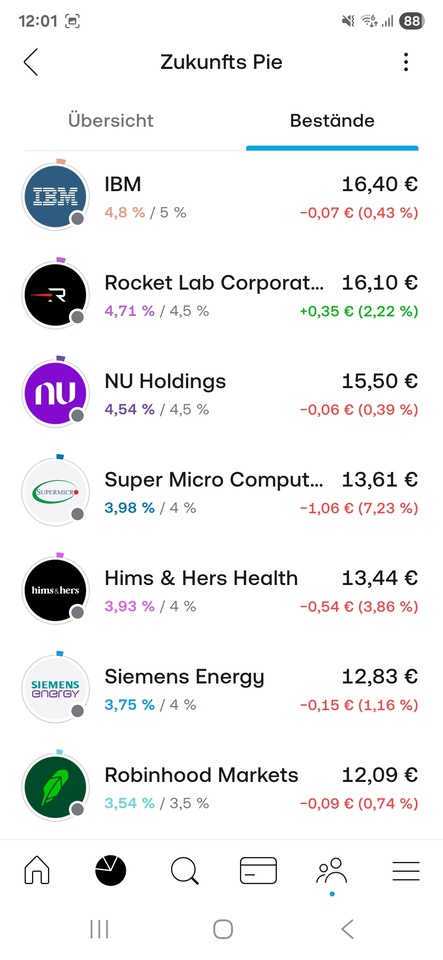
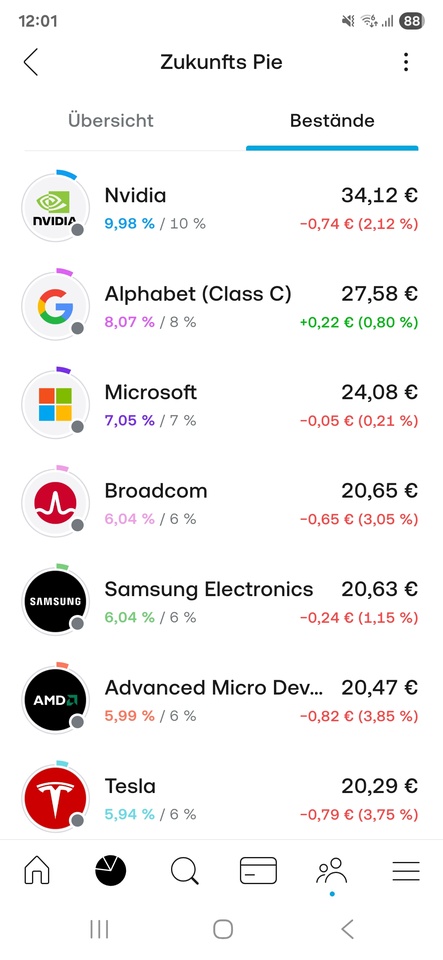
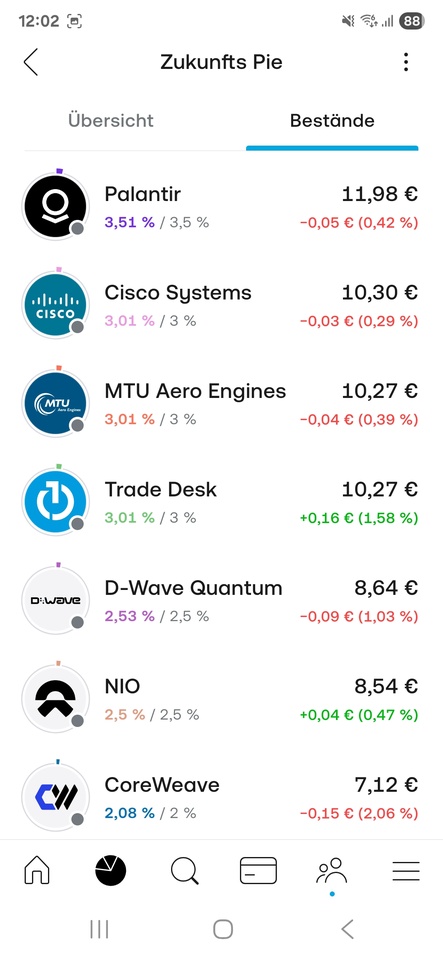
However, I see Tesla as doomed🙈🫡
Nevertheless, I wish everyone (who doesn't push Tesla as the most valuable company in the world) good luck :)
Megatrend robotics, freshly updated, added value guaranteed!
After my first post on humanoid robots received a lot of positive feedback, I went into more detail. I have subsequently added my favorites in each sector.
Extended analysis of the value chain including shovel manufacturers and potential hidden champions
New categorySecondary key sectors (sales, marketing, financing)
In additionTop 25 companies worldwide, as well as Top 10 Europe and Top 10 Asia
I have also added a video link for beginners. This will give you an idea of how far the development of humanoid robotics has already progressed.
Thank you for your attention and your support 🙏
🌐 1. value chain of humanoid robots (with hidden champions)
1. research & chip design
$ARM (-4,94 %) ARM (UK) - CPU-IP, energy-efficient processors
$SNPS (-4,99 %) Synopsys (US) - EDA software, chip design
$CDNS (-3,82 %) Cadence (US) - EDA & Simulation
$PTC PTC (US) - Engineering Software, CAD/PLM
$DSY (+1,38 %) Dassault Systèmes (FR) - 3D Design & Digital Twin
$SIE (-0,88 %) Siemens (DE) - Industrial Software & Lifecycle Mgmt
$ADBE (+1,2 %) Adobe (US) - Design, AR/UX
ANSYS (US) - multiphysical simulation - acquisition by Synopsis
Altair (US) - CAE, simulation, digital twin - acquisition by Siemens
$HXGBY (-0,25 %)
Hexagon (SE) - Metrology & Simulation
$AWE (-14,62 %) Alphawave IP Group (UK) - High-speed chip IP for AI/robotics
1.Synopsis, 2.Siemens and 3.Adobe are my top 3 in this sector
2. manufacturing technology & equipment
$ASML (-3,69 %) ASML (NL) - Lithography (EUV)
$AMAT (-4,67 %) Applied Materials (US) - Semiconductor equipment
$8035 (-6,59 %) Tokyo Electron (JP) - wafer fabrication
$KEYS (-2,61 %) Keysight Technologies (US) - Metrology
$6857 (-5,43 %) Advantest (JP) - Chip test systems
$TER (-6,15 %) Teradyne (US) - test systems + cobots
$6954 (+2,24 %) Fanuc (JP) - Industrial robots, CNC
$CAT (-3,04 %) Caterpillar (US) - autonomous machines
$KU2G KUKA (DE) - industrial robots
Comau (IT) - automation - not listed on the stock exchange
$ROK Rockwell Automation (US) - industrial automation
$JBL (-5,38 %) Jabil (US) - contract manufacturing (EMS/ODM)
$KIT (-1,21 %) Kitron (NO) - European EMS/ODM manufacturer
$AIXA (-4,16 %) Aixtron (DE) - deposition equipment for compound semiconductors
$LRCX (-5,41 %)
Lam Research (US) - Etch/deposition systems
$MKSI (-6,63 %)
MKS Instruments (US) - Plasma/vacuum technology
$ASM (-5,4 %)
ASM International (NL) - Deposition systems
1.ASML, 2.Keysight Technologies, 3.Fanuc are my top 3 in this sector
3. chip manufacturing (foundries)
$TSM (-4,23 %) TSMC (TW) - leading foundry
$SMSN Samsung Electronics (KR) - foundry + memory
$GFS (-3,26 %) GlobalFoundries (US) - specialty chips
$INTC (-4,8 %)
Intel Foundry Services (US) - new western foundry player
$981
SMIC (CN) - largest Chinese foundry
$UMC
UMC (TW) - Power/RF/Embedded chips
1.TSMC, 2.Intel, 3.Samsung Electronics are my top 3 in this sector
4. computing & control unit ("brain")
$NVDA (-3,26 %) Nvidia (US) - GPUs, AI chips
$INTC (-4,8 %) Intel (US) - CPUs, FPGAs
$AMD (-4,68 %) AMD (US) - CPUs, GPUs
$MRVL (-5,92 %) Marvell (US) - Network Chips
$MU (-7,24 %) Micron (US) - Memory
$DELL (-6,71 %) Dell Technologies (US) - Edge & Infrastructure
Graphcore (UK) - AI chips (IPU) - not a listed company
Cerebras (US) - Wafer-scale engine - not a listed company
SiPearl (FR) - European HPC chip - not a listed company
1.Nvidia, 2.Marvell, 3.Micron are my top 3 in this sector
5. sensors ("senses")
$6758 (-0,26 %) Sony (JP) - image sensors
$6861 (+0,34 %) Keyence (JP) - Industrial sensors
$STM (-0,9 %) STMicroelectronics (FR/IT) - Sensors, MCUs
$TDY Teledyne (US) - optical/infrared sensors
$CGNX (-3,02 %) Cognex (US) - Machine Vision
$HON (-0,17 %) Honeywell (US) - sensor technology, security
ANYbotics (CH) - autonomous sensor fusion - not a listed company
$AMBA (-5,27 %) Ambarella (US) - video & computer vision SoCs for real-time image recognition
$OUST
Velodyne Lidar (US) - Lidar sensors - acquisition by Ouster
$AMS (+3,3 %)
OSRAM (AT/DE) - optical sensors
1.Teledyne, 2.Keyence, 3.Ouster are my top 3 in this sector
6. actuators & power electronics ("muscles")
$IFX (-1,76 %) Infineon (DE) - Power Electronics
$ON (-2,62 %) onsemi (US) - Power & Sensors
$TXN (-1,12 %) Texas Instruments (US) - Mixed-Signal Chips
$ADI (-1,8 %) Analog Devices (US) - Signal Processing
$PH Parker-Hannifin (US) - Hydraulics/Pneumatics
$MP (-5,66 %) MP Materials (US) - Magnets
$APH (-7,11 %) Amphenol (US) - Connectors
$6481 (-2,14 %) THK (JP) - Linear guides & actuators
$6324 (+0,47 %)
Harmonic Drive (JP) - Precision gears & servo drives for robotics
$6594 (+0,18 %)
Nidec (JP) - Electric motors
$6506 (-0,48 %)
Yaskawa (JP) - Drives & Robotics
$SU (-1,35 %)
Schneider Electric (FR) - Energy & control solutions
$ZIL2 (-0,61 %)
ElringKlinger (DE) - Battery & fuel cell technology, lightweight construction
1.Parker-Hannifin, 2.MP Materials, 3.Infinion are my top 3 in this sector
7. communication & networking ("nerves")
$QCOM (-2,01 %) Qualcomm (US) - mobile communications, edge AI
$ANET (-7,57 %) Arista Networks (US) - Networks
$CSCO (-2,24 %) Cisco (US) - Networks, Security
$EQIX (-0,76 %) Equinix (US) - Data centers
NTT Docomo (JP) - 5G/6G carrier - not a listed company
$VZ Verizon (US) - Telecommunications
$SFTBY SoftBank (JP) - Carrier + Robotics
$ERIC B (-1,6 %)
Ericsson (SE) - 5G/IoT infrastructure
$NOKIA (-2,73 %)
Nokia (FI) - 5G/6G for industry
$HPE (-5,2 %)
Juniper Networks (US) - Network technology - acquisition by HP
1.Arista Networks, 2.SoftBank, 3.Cisco are my top 3 in this sector
8. energy supply
$3750 (+0,54 %) CATL (CN) - Batteries
$6752 (+4,32 %) Panasonic (JP) - Batteries
$373220 LG Energy (KR) - Batteries
$ALB (+0,15 %) Albemarle (US) - Lithium
$LYC (-0,78 %) Lynas (AU) - Rare earths
$UMICY (+2,54 %) Umicore (BE) - recycling
WiTricity (US) - inductive charging - not a listed company
$ABBN (-1,06 %) Charging (CH) - charging infrastructure
$SLDP
Solid Power (US) - Solid state batteries
Northvolt (SE) - European batteries - not a listed company
$PLUG
Plug Power (US) - fuel cells
$KULR (-2,11 %)
KULR Technology (US) - Thermal management & battery safety for mobile systems
1.Albemarle, 2.CATL, 3.Panasonic are my top 3 in this sector
9. cloud & infrastructure
$AMZN (-2,35 %) Amazon AWS (US) - Cloud, AI
$MSFT (-0,32 %) Microsoft Azure (US) - Cloud, AI
$GOOG (-3,34 %) Alphabet Google Cloud (US) - Cloud, ML
$VRT
Vertiv Holdings (US) - Data center infrastructure (UPS, cooling, edge)
$ORCL (-4,75 %)
Oracle Cloud (US) - ERP + Cloud
$IBM (-0,58 %)
IBM Cloud (US) - Hybrid cloud + AI
$OVH (-0,32 %)
OVHcloud (FR) - European cloud
1.Alphabet, 2.Microsoft, 3.Oracle are my top 3 in this sector
10. software & data platforms
$PLTR (-2,82 %) Palantir (US) - Data integration
$DDOG (-3,12 %) Datadog (US) - Monitoring
$SNOW (-1,63 %) Snowflake (US) - Data Cloud
$ORCL (-4,75 %) Oracle (US) - Databases, ERP
$SAP (-0,93 %) SAP (DE) - ERP systems
$SPGI (+0,57 %) S&P Global (US) - financial/market data
ROS2 Foundation - robotics middleware - not listed on the stock exchange
$NVDA (-3,26 %) NVIDIA Isaac (US) - robotics development - part of Nvidia
$INOD (-3,92 %) Innodata (US) - data annotation & AI training data
$PATH (-4,21 %)
UiPath (RO/US) - Robotic process automation
$AI (-4,63 %)
C3.ai (US) - AI platform
$ESTC (-3,77 %)
(NL/US) - Search & data analysis
1.S&P Global, 2.Palantir, 3.Datadog are my top 3 in this sector
11. end applications / robots
$ABBN (-1,06 %) ABB (CH/SE) - Industrial Robots
$6954 (+2,24 %) Fanuc (JP) - Industrial robots
$TSLA (+1,52 %) Tesla Optimus (US) - humanoid robot
$9618 (-0,36 %) JD.com (CN) - logistics robot
$AAPL (-0,42 %) Apple (US) - Platform & UX
$700 (+0,26 %) Tencent (CN) - Platform & AI
$9988 (-0,52 %) Alibaba (CN) - logistics & platform
PAL Robotics (ES) - humanoid robots - not a listed company
Neura Robotics (DE) - cognitive humanoid robots - not a listed company
$TER (-6,15 %) Universal Robots (DK) - cobots - belongs to the Teradyne Corporation
Engineered Arts (UK) - humanoid robots - not a listed company
$ISRG (-0,67 %) Intuitive Surgical (US) - surgical robotics
$GMED (-2,64 %)
Globus Medical (US) - surgical robotics (ExcelsiusGPS platform)
$7012 (+1,52 %) Kawasaki Heavy Industries (JP) - industrial robots, automation
$CPNG (-1,03 %) Coupang (KR) - Logistics end user
$IRBT (-9,98 %)
iRobot (US) - consumer robotics (e.g. Roomba), non-humanoid, but navigation/sensor fusion
Boston Dynamics (US) - humanoid & mobile robots-no listed company
Hanson Robotics (HK) - humanoid robots (Sophia) - not a listed company
Agility Robotics (US) - humanoid robot "Digit" - not a listed company
1.Apple, 2.Tencent, 3.Alibaba are my top 3 in this sector
🛠 2. cross enablers (shovel manufacturers) - with hidden champions
Raw materials & battery materials
Albemarle - Lynas - Umicore
$SQM
SQM (CL) - Lithium
$ILU (+0,62 %)
Iluka Resources (AU) - Rare earths
$ARR (-4,35 %)
American Rare Earths (US/AU) - New supply chains
my number 1 in the sector is Albemarle
manufacturing technology
ASML - Applied Materials - Tokyo Electron
$LRCX (-5,41 %)
Lam Research (US) - Plasma/etching processes
$ASM (-5,4 %)
ASM International (NL) - ALD equipment
$MKSI (-6,63 %)
MKS Instruments (US) - Plasma/vacuum technology
my number 1 in the sector is ASML
Quality assurance
Keysight - Advantest - Teradyne
$EMR (-0,49 %)
National Instruments (US) - Measurement technology - from Emerson Electric adopted
$300567
ATE Test Systems (CN) - test systems
$FORM (-4,84 %)
FormFactor (US) - Wafer probing
my number 1 in the sector is Keysight
Motion & Drive
Parker-Hannifin
Festo (DE) - Pneumatics, Soft Robotics - not a listed company
Bosch Rexroth (DE) - Drives, Controls - not a listed company
$6481 (-2,14 %)
THK (JP) - Linear guides
my number 1 in the sector is Parker-Hannifin
Sensors/Imaging
$TDY Teledyne
$BSL (-3,11 %) Basler (DE) - Industrial cameras
FLIR (US) - Thermal imaging sensors - acquisition by Teledyne
ISRA Vision (DE) - Machine Vision - not a listed company
my number 1 in the sector is Teledyne
Magnets & Materials
MP Materials
$6501 (+0,75 %)
Hitachi Metals (JP) - Magnetic materials
VacuumSchmelze (DE) - Magnetic materials - not a listed company
$4063 (+0,78 %)
Shin-Etsu Chemical (JP) - Specialty materials
my number 1 in the sector is MP Materials
Chip Design & Simulation
Synopsys - Cadence - ARM
$SIE (-0,88 %)
Siemens EDA (DE/US)-Mentor Graphics-strategic business unit of Siemens AG
Imagination Tech (UK) - GPU-IP - not a listed company
$CEVA (-7 %)
CEVA (IL) - Signal Processor IP
my number 1 in the sector is Synopsys
Engineering & Lifecycle
PTC - Dassault - Siemens
Altair (US) - Simulation - no longer a listed company
$HXGBY (-0,25 %)
Hexagon (SE) - Metrology
$SNPS (-4,99 %)
ANSYS (US) - Simulation - takeover by Synopsys
my number 1 in the sector is Siemens
Networks & Data Centers
Arista - Cisco - Equinix
$HPE (-5,2 %)
Juniper (US) - Networks - Acquisition of HPE
$DTE (-0,8 %)
T-Systems (DE) - Industry cloud
$OVH (-0,32 %)
OVHcloud (FR) - European cloud
my number 1 in the sector is Arista
Cloud infrastructure
AWS - Azure - Google Cloud
$ORCL (-4,75 %)
Oracle Cloud (US) - ERP & databases
$IBM (-0,58 %)
IBM Cloud (US) - Hybrid Cloud
$9988 (-0,52 %)
Alibaba Cloud (CN) - Asian Cloud
$VRT
Vertiv Holdings (US) - Cloud/Infra
my number 1 in the sector is Alphabet (Google)
finance/information infra
S&P Global
$MCO (+0,19 %)
Moody's (US) - Ratings
$MSCI (+1,92 %)
MSCI (US) - Indices
$MORN
Morningstar (US) - Investment Research
my number 1 in the sector is S&P Global
Creative/Experience Infra
Adobe
$ADSK (-1,11 %)
Autodesk (US) - CAD & Design
$U
Unity (US) - 3D/AR simulation
Epic Games (US) - Unreal Engine - not a listed company
my number 1 in the sector is Adobe
Platform & Ecosystem
Apple - Tencent - Alibaba
$META (-1,55 %)
Meta (US) - AR/VR, Social Robotics
ByteDance (CN) - AI & platforms - not a listed company
$9888 (-2,56 %)
Baidu (CN) - AI & Cloud
my number 1 in the sector is Tencent
Infrastructure/Edge
Dell
$HPE (-5,2 %)
HPE (US) - Edge Computing
$SMCI (-6,61 %)
Supermicro (US) - AI servers
$6702 (+1,15 %)
Fujitsu (JP) - Edge & HPC
my number 1 in the sector is Dell
storage solutions
Micron
$HY9H (-4,1 %)
SK Hynix (KR) - Memory
$285A (-1,84 %)
Kioxia (JP) - NAND
$WDC
Western Digital (US) - Storage solutions
my number 1 in the sector is Micron
🏛 3. secondary key sectors with hidden champions
Financing & Capital
$GS (-2,91 %) Goldman Sachs (US) - investment bank; ECM/DCM, M&A, growth financing
$MS Morgan Stanley (US) - investment bank; tech banking, capital markets
$BLK (-0,06 %) BlackRock (US) - asset manager; capital allocation, ETFs/index funds
$9984 (-3,49 %) SoftBank Vision Fund (JP) - mega VC; growth equity in robotics/AI
Sequoia Capital (US) - venture capital; early/growth in AI/robotics - this is a classic venture capital fund
DARPA (US) - government R&D funding (robotics/defense) - independent research and development agency
EU Horizon (EU) - research funding/grants for DeepTech - Innovative Europe pillar
China State Funds (CN) - state industry/technology fund
Lux Capital (US) - VC for DeepTech - Uptake (US) - AI-based predictive maintenance
DCVC (US) - Robotics & AI focus - investing exclusively via VC fund investments
Speedinvest (AT) - EU VC for robotics - access to investment only via fund investments
my number 1 in the sector is Softbank
Maintenance & Service
$SIE (-0,88 %) Siemens (DE) - Industrial Service, Lifecycle & Retrofit
$ABBN (-1,06 %) ABB (CH/SE) - Robotics Service, Spare Parts, Field Support
$GEHC (-1,1 %) GE Healthcare (US) - Medtech service incl. robotic systems
Uptake (US) - AI-based predictive maintenance - not a listed company
Augury (US/IL) - condition monitoring, condition diagnostics - not a listed company
$KU2 KUKA Service (DE) - Robotics maintenance
$6954 (+2,24 %) Fanuc Service (JP) - global service network
Boston Dynamics AI Institute (US) - Robotics longevity - funded by Hyundai Motor Group
my number 1 in the sector is Siemens
Marketing & Advertising
$WPP (-0,27 %) WPP (UK) - global advertising group; branding/communications
$OMC Omnicom (US) - marketing/PR network
$PUB (+0,16 %) Publicis (FR) - communications/advertising group
$META (-1,55 %) Meta (US) - Digital Ads (Facebook/Instagram)
$GOOG (-3,34 %) Google Ads (US) - search & display advertising
TikTok / ByteDance (CN) - social ads & distribution - not a listed company
$AAPL (-0,42 %) Apple (US) - Branding/UX; Acceptance & Platform Marketing
$WPP (-0,27 %)
AKQA (UK/US) - Tech branding - Since 2012 majority owned by the WPP Groupbut continues to operate as an autonomous operating unit
R/GA (US) - Innovation marketing - not a listed company
Serviceplan (DE) - largest independent EU agency - not a listed company
my number 1 in the sector is Meta
Law, Regulation & Ethics
ISO (CH) - international standards, robotics standards
TÜV (DE) - certification & safety tests
UL (US) - safety/conformity testing
EU AI Act (EU) - legal framework for AI & robotics
UNESCO AI Ethics (UN) - global ethics guidelines
Fraunhofer IPA (DE) - Robotics safety standards
ANSI (US) - standards
IEC (CH) - Electrical engineering standards
Training & Talent
MIT (US) - Robotics/AI Research & Education
ETH Zurich (CH) - autonomous systems & robotics
Stanford (US) - AI/Robotics labs & spin-offs
Tsinghua University (CN) - Robotics/AI in Asia
CMU (US) - Robotics Institute
EPFL (CH) - Robotics research
TU Munich (DE) - humanoid robot "Roboy"
🌍 Top 25 companies for humanoid robotics
These companies are central to the development & production of humanoid robotsbecause without them, crucial parts of the chain would be missing:
Chips & computing power (brain of the robots)
$NVDA (-3,26 %) Nvidia (US) - AI GPUs & Isaac platform, foundation for robotic AI
$2330 TSMC (TW) - world's most important foundry, produces the AI chips
$ASML (-3,69 %) ASML (NL) - EUV lithography, indispensable for chip production
$005930 Samsung Electronics (KR) - memory, logic, foundry
$HY9H (-4,1 %) SK Hynix (KR) - DRAM & NAND memory for AI
$MU (-7,24 %) Micron (US) - Memory solutions for AI workloads
my number 1 in the sector is ASML
Sensors & perception (senses of robots)
$SONY Sony (JP) - image sensors, market leader
$6861 (+0,34 %) Keyence (JP) - Industrial sensors & vision systems
$CGNX (-3,02 %) Cognex (US) - Machine Vision, precise image processing
my number 1 in the sector is Keyence
Actuators & motion (muscles of robots)
$IFX (-1,76 %) Infineon (DE) - power electronics, motor control
$6594 (+0,18 %) Nidec (JP) - World market leader for electric motors
$PH Parker-Hannifin (US) - hydraulics/pneumatics, motion technology
$6481 (-2,14 %) THK (JP) - Linear guides & actuators
my number 1 in the sector is Parker-Hannifin
Communication, cloud & infrastructure (nerves & data flow)
$QCOM (-2,01 %) Qualcomm (US) - Mobile & Edge Chips
$AMZN (-2,35 %) Amazon AWS (US) - Cloud & AI infrastructure
$MSFT (-0,32 %) Microsoft Azure (US) - Cloud, AI services
$CSCO (-2,24 %) Cisco (US) - Networks & Security
$VRT Vertiv Holdings (US) - Data Center Infrastructure
my number 1 in the sector is Microsoft
End Applications & Platforms (robots themselves)
$TSLA (+1,52 %) Tesla (US) - humanoid robot Optimus
$ABBN (-1,06 %) ABB (CH/SE) - Robotics & Automation
$6954 (+2,24 %) Fanuc (JP) - industrial robots & CNC systems
$7012 (+1,52 %) Kawasaki Heavy Industries (JP) - industrial robots
PAL Robotics (ES) - humanoid robots (TALOS, ARI, TIAGo) - not a listed company
Neura Robotics (DE) - cognitive humanoid robots - not a listed company
Universal Robots (DK) - cobots
my number 1 in the sector is Tesla
🇪🇺 Top 10 European key companies for humanoid robotics
$ASML (-3,69 %)
ASML (NL)
World market leader in EUV lithography - no modern chips for AI & robotics without ASML.
$IFX (-1,76 %) Infineon (DE)
Leading in power electronics & motor control - crucial for actuators of humanoid robots.
$STM (-0,9 %)
STMicroelectronics (FR/IT)
Sensors, microcontrollers & power chips - the basis for control & perception.
$SAP (-0,93 %)
SAP (DE)
ERP & data platforms, important for integrating humanoid robots into industrial processes.
$SIE (-0,88 %)
Siemens (DE)
Industrial software, automation, digital twin - key for engineering & lifecycle management.
$KU2 KUKA (EN)
Robotics pioneer, industrial robots & automation - know-how for humanoid motion mechanics.
PAL Robotics (ES) - not a listed company
Specialist for humanoid robots (TALOS, ARI, TIAGo), internationally used in research & service.
Neura Robotics (DE) - Not a listed company
Young high-tech company, develops cognitive humanoid robots with advanced AI (4NE-1).
Universal Robots (DK) - Not a listed company
Market leader for cobots - platform for safe human-robot collaboration.
Engineered Arts (UK) - not a listed company
Develops humanoid robots such as Amecaknown for realistic facial expressions & gestures - important for HRI (Human-Robot Interaction)
🌏 Top 10 Asian key companies for humanoid robotics
$2330
TSMC (Taiwan)
World's largest semiconductor foundry, produces high-end chips (e.g. Nvidia, AMD, Apple) - no AI hardware without TSMC.
$005930
Samsung Electronics (South Korea)
Foundry, memory, logic chips, image sensors - extremely broadly positioned in robotics components.
$HY9H (-4,1 %)
SK Hynix (KR) - Memory
$SONY
Sony (Japan)
Market leader in CMOS image sensors, essential for robotic vision & perception.
$6861 (+0,34 %)
Keyence (Japan)
Sensor technology & machine vision for industrial automation, widely used in robotics.
$6954 (+2,24 %)
Fanuc (Japan)
Industrial robots & CNC systems, one of the most important manufacturers of robotics hardware worldwide.
$6506 (-0,48 %)
Yaskawa Electric (Japan)
Drives, motion control & robot arms - relevant for humanoid motion control.
$6594 (+0,18 %)
Nidec (Japan)
World market leader for electric motors (from mini motors to high-performance drives).
$7012 (+1,52 %)
Kawasaki Heavy Industries (JP) - Industrial robots
$9618 (-0,36 %)
JD.com (China)
Driver for robotics in e-commerce & logistics, invests in humanoid robotics applications
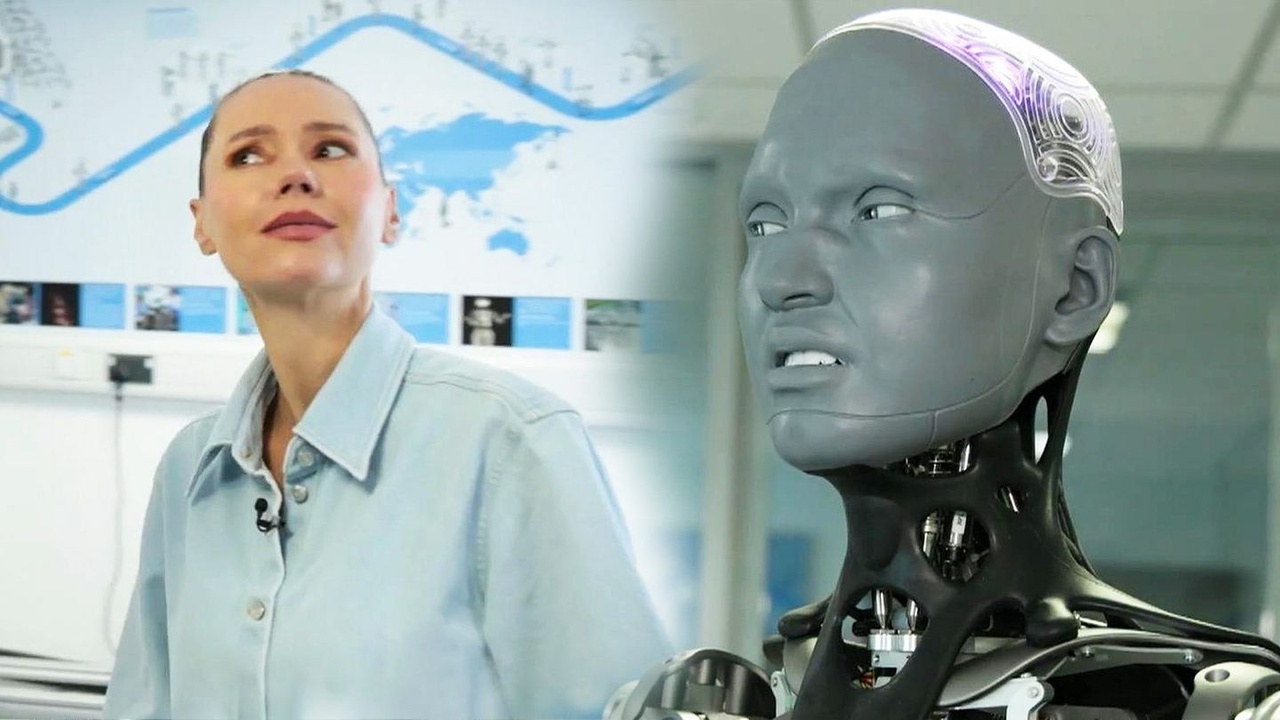
Build robots, earn shovels
The hype is all about humanoid robots, but the constant winners are in the background.
I have divided the analysis into two perspectives. 1. the complete value chain of humanoid robots, which shows all the players from the chip to the finished robot, and 2. the blade manufacturers in the background, who always earn money as enablers, regardless of which manufacturer wins the race.
ASML, Applied Materials and Tokyo Electron dominate in manufacturing technology. Quality assurance comes from Keysight, Advantest and Teradyne. Chip design is supported by Synopsys, Cadence and ARM. Data streams are secured by Arista Networks, Cisco and Equinix. The computing basis is created in the cloud by Amazon, Microsoft and Alphabet. Albemarle, Lynas and Umicore play a central role in raw materials and battery materials. These companies monetize their customers' investment waves, have high barriers to entry, service revenues and pricing power, but remain cyclical with risks from export rules, capex cuts and currency movements.
🌐 Value chain of humanoid robots Sector overview
1. research & chip design (IP / EDA)
$ARM (-4,94 %)
ARM Holdings (ARM, UK/USA) - CPU architectures
$SNPS (-4,99 %)
Synopsys (SNPS, USA) - Chip design software
$CDNS (-3,82 %)
Cadence Design Systems (CDNS, USA) - EDA & Simulation
2. manufacturing technology & equipment
$ASML (-3,69 %)
ASML (ASML, NL) - EUV lithography, key monopoly
$AMAT (-4,67 %)
Applied Materials (AMAT, USA) - Process equipment
$8035 (-6,59 %)
Tokyo Electron (8035.T, JP) - Wafer equipment
$KEYS (-2,61 %)
Keysight Technologies (KEYS, USA) - Test & RF measurement technology
$6857 (-5,43 %)
Advantest (6857.T, JP) - Semiconductor test systems
$TER (-6,15 %)
Teradyne (TER, USA) - Test systems + robotics (Universal Robots)
3. chip production (Foundries)
$TSM (-4,23 %)
TSMC (TSM, TW) - Largest contract manufacturer
$005930
Samsung Electronics (005930.KQ, KR) - Memory + Foundry
$GFS (-3,26 %)
GlobalFoundries (GFS, USA) - Specialized production
4. computing & control unit ("brain")
$NVDA (-3,26 %)
Nvidia (NVDA, USA) - GPUs, AI accelerators
$INTC (-4,8 %)
Intel (INTC, USA) - CPUs, FPGAs
$AMD (-4,68 %)
AMD (AMD, USA) - CPUs/GPUs
$MRVL (-5,92 %)
Marvell Technology (MRVL, USA) - Network/data center chips
5. sensors ("senses")
$6758 (-0,26 %)
Sony (6758.T, JP) - CMOS image sensors
$6861 (+0,34 %)
Keyence (6861.T, JP) - Vision systems, sensors
$STM (-0,9 %)
STMicroelectronics (STM, CH/FR) - MEMS sensors
6. actuators & power electronics ("muscles")
$IFX (-1,76 %)
Infineon (IFX, DE) - Power semiconductors, SiC
$ON (-2,62 %)
N Semiconductor (ON, USA) - SiC/Power Chips
$STM (-0,9 %)
STMicroelectronics (STM, CH/FR) - Motor control & power
$TXN (-1,12 %)
Texas Instruments (TXN, USA) - Motor control, power ICs
$ADI (-1,8 %)
Analog Devices (ADI, USA) - Energy & BMS chips
7. communication & networking ("nerves")
$QCOM (-2,01 %)
Qualcomm (QCOM, USA) - 5G/SoCs
$AVGO (-14,32 %)
Broadcom (AVGO, USA) - Network & radio chips
$SWKS (-2,11 %)
Skyworks Solutions (SWKS, USA) - RF components
8. energy supply
$300750
CATL (300750.SZ, CN) - Batteries
$6752 (+4,32 %)
Panasonic (6752.T, JP) - Batteries for automotive/robotics
$373220
LG Energy Solution (373220.KQ, KR) - Batteries
9. cloud & infrastructure
$AMZN (-2,35 %)
Amazon (AMZN, USA) - AWS
$MSFT (-0,32 %)
Microsoft (MSFT, USA) - Azure
$GOOG (-3,34 %)
Alphabet (GOOGL, USA) - Google Cloud
$EQIX (-0,76 %)
Equinix (EQIX, USA) - Data center operator
$ANET (-7,57 %)
Arista Networks (ANET, USA) - Network infrastructure
$CSCO (-2,24 %)
Cisco Systems (CSCO, USA) - Edge & Data Center Networks
10. software & data platforms
$PLTR (-2,82 %)
Palantir (PLTR, USA) - Data integration, decision software
$DDOG (-3,12 %)
Datadog (DDOG, USA) - Cloud monitoring / observability
$SNOW (-1,63 %)
Snowflake (SNOW, USA) - Cloud-native data platform
$ORCL (-4,75 %)
Oracle (ORCL, USA) - Databases, ERP
$SAP (-0,93 %)
SAP (SAP, DE) - ERP/cloud systems
$PATH (-4,21 %)
UiPath (PATH, USA) - Automation software (RPA)
$AI (-4,63 %)
C3.ai (AI, USA) - Enterprise AI platform
11. end applications / robots
$ABB
ABB (ABB, CH) - Industrial robots
$6954 (+2,24 %)
Fanuc (6954.T, JP) - Industrial robots, CNC
$TSLA (+1,52 %)
Tesla (TSLA, USA) - Optimus" humanoid robot
$9618 (-0,36 %)
JD.com (JD, CN) - E-commerce & automated logistics
🛠️ Shovel manufacturer for humanoid robots
🔹 Hardtech (physical "shovels")
These companies provide the material basis: manufacturing machines, raw materials, semiconductor base.
Semiconductor Equipment & Manufacturing
$ASML (-3,69 %)
ASML (ASML, NL) - EUV lithography (monopoly).
$AMAT (-4,67 %)
Applied Materials (AMAT, USA) - Wafer equipment.
$8035 (-6,59 %)
Tokyo Electron (8035.T, JP) - Process equipment.
Test systems (hardware-side)
$6857 (-5,43 %)
Advantest (6857.T, JP) - Semiconductor test.
$TER (-6,15 %)
Teradyne (TER, USA) - Test systems + industrial robots.
Materials & raw materials
$ALB (+0,15 %)
Albemarle (ALB, USA) - Lithium (batteries).
$LYC (-0,78 %)
Lynas Rare Earths (LYC.AX, AUS) - Rare earths for magnets.
$UMICY (+2,54 %)
Umicore (UMI.BR, BE) - Cathode materials, recycling.
🔹 Soft/infra (digital "shovels")
These companies supply the infrastructure & toolswithout which development, training and operation would be impossible.
Design Software & IP
$SNPS (-4,99 %)
Synopsys (SNPS, USA) - EDA software.
$CDNS (-3,82 %)
Cadence Design Systems (CDNS, USA) - Chip design & simulation.
$ARM (-4,94 %)
ARM Holdings (ARM, UK/USA) - CPU architectures (license model).
Test & Measurement (software/signal level)
$KEYS (-2,61 %)
Keysight Technologies (KEYS, USA) - Electronics & RF test systems.
Network & data center backbone
$ANET (-7,57 %)
Arista Networks (ANET, USA) - High-speed networks.
$CSCO (-2,24 %)
Cisco Systems (CSCO, USA) - Data center/edge networks.
$EQIX (-0,76 %)
Equinix (EQIX, USA) - Data centers (colocation).
Cloud infrastructure
$AMZN (-2,35 %)
Amazon (AMZN, USA) - AWS (cloud, AI training).
$MSFT (-0,32 %)
Microsoft (MSFT, USA) - Azure.
$GOOG (-3,34 %)
Alphabet (GOOGL, USA) - Google Cloud.
Takeaway: Investing in the infrastructure stack allows you to participate in the robotics trend regardless of the subsequent product winner and reduces the individual product risk, but you have to live with cycles. In your opinion, which stage of the chain offers the best risk/return combination and fits into a disciplined portfolio?
Source: Own analysis based on publicly available company information and IR materials of the companies mentioned.
Image material: Techa Tungateja/iStockphoto
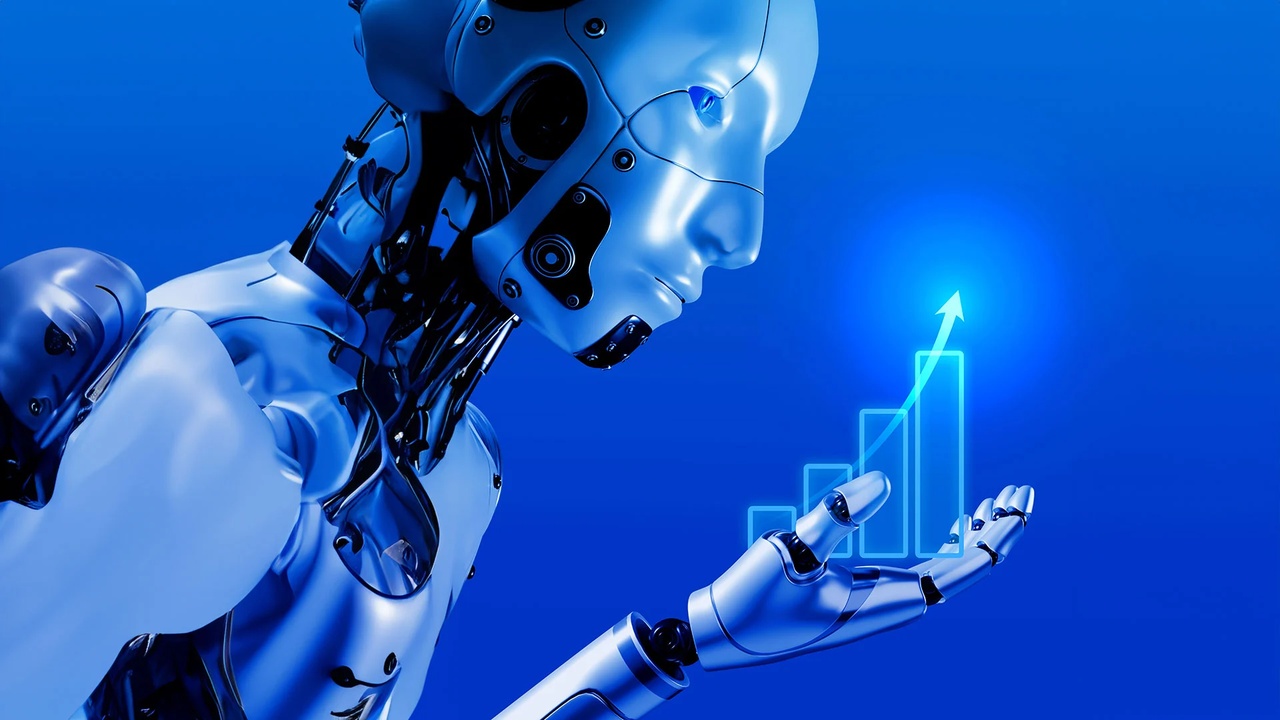
Build robots, earn shovels
The hype is all about humanoid robots, but the constant winners are in the background.
I have divided the analysis into two perspectives. 1. the complete value chain of humanoid robots, which shows all the players from the chip to the finished robot, and 2. the blade manufacturers in the background, who always earn money as enablers, regardless of which manufacturer wins the race.
ASML, Applied Materials and Tokyo Electron dominate in manufacturing technology. Quality assurance comes from Keysight, Advantest and Teradyne. Chip design is supported by Synopsys, Cadence and ARM. Data streams are secured by Arista Networks, Cisco and Equinix. The computing basis is created in the cloud by Amazon, Microsoft and Alphabet. Albemarle, Lynas and Umicore play a central role in raw materials and battery materials. These companies monetize their customers' investment waves, have high barriers to entry, service revenues and pricing power, but remain cyclical with risks from export rules, capex cuts and currency movements.
🌐 Value chain of humanoid robots Sector overview
1. research & chip design (IP / EDA)
$ARM (-4,94 %)
ARM Holdings (ARM, UK/USA) - CPU architectures
$SNPS (-4,99 %)
Synopsys (SNPS, USA) - Chip design software
$CDNS (-3,82 %)
Cadence Design Systems (CDNS, USA) - EDA & Simulation
2. manufacturing technology & equipment
$ASML (-3,69 %)
ASML (ASML, NL) - EUV lithography, key monopoly
$AMAT (-4,67 %)
Applied Materials (AMAT, USA) - Process equipment
$8035 (-6,59 %)
Tokyo Electron (8035.T, JP) - Wafer equipment
$KEYS (-2,61 %)
Keysight Technologies (KEYS, USA) - Test & RF measurement technology
$6857 (-5,43 %)
Advantest (6857.T, JP) - Semiconductor test systems
$TER (-6,15 %)
Teradyne (TER, USA) - Test systems + robotics (Universal Robots)
3. chip production (Foundries)
$TSM (-4,23 %)
TSMC (TSM, TW) - Largest contract manufacturer
$005930
Samsung Electronics (005930.KQ, KR) - Memory + Foundry
$GFS (-3,26 %)
GlobalFoundries (GFS, USA) - Specialized production
4. computing & control unit ("brain")
$NVDA (-3,26 %)
Nvidia (NVDA, USA) - GPUs, AI accelerators
$INTC (-4,8 %)
Intel (INTC, USA) - CPUs, FPGAs
$AMD (-4,68 %)
AMD (AMD, USA) - CPUs/GPUs
$MRVL (-5,92 %)
Marvell Technology (MRVL, USA) - Network/data center chips
5. sensors ("senses")
$6758 (-0,26 %)
Sony (6758.T, JP) - CMOS image sensors
$6861 (+0,34 %)
Keyence (6861.T, JP) - Vision systems, sensors
$STM (-0,9 %)
STMicroelectronics (STM, CH/FR) - MEMS sensors
6. actuators & power electronics ("muscles")
$IFX (-1,76 %)
Infineon (IFX, DE) - Power semiconductors, SiC
$ON (-2,62 %)
N Semiconductor (ON, USA) - SiC/Power Chips
$STM (-0,9 %)
STMicroelectronics (STM, CH/FR) - Motor control & power
$TXN (-1,12 %)
Texas Instruments (TXN, USA) - Motor control, power ICs
$ADI (-1,8 %)
Analog Devices (ADI, USA) - Energy & BMS chips
7. communication & networking ("nerves")
$QCOM (-2,01 %)
Qualcomm (QCOM, USA) - 5G/SoCs
$AVGO (-14,32 %)
Broadcom (AVGO, USA) - Network & radio chips
$SWKS (-2,11 %)
Skyworks Solutions (SWKS, USA) - RF components
8. energy supply
$300750
CATL (300750.SZ, CN) - Batteries
$6752 (+4,32 %)
Panasonic (6752.T, JP) - Batteries for automotive/robotics
$373220
LG Energy Solution (373220.KQ, KR) - Batteries
9. cloud & infrastructure
$AMZN (-2,35 %)
Amazon (AMZN, USA) - AWS
$MSFT (-0,32 %)
Microsoft (MSFT, USA) - Azure
$GOOG (-3,34 %)
Alphabet (GOOGL, USA) - Google Cloud
$EQIX (-0,76 %)
Equinix (EQIX, USA) - Data center operator
$ANET (-7,57 %)
Arista Networks (ANET, USA) - Network infrastructure
$CSCO (-2,24 %)
Cisco Systems (CSCO, USA) - Edge & Data Center Networks
10. software & data platforms
$PLTR (-2,82 %)
Palantir (PLTR, USA) - Data integration, decision software
$DDOG (-3,12 %)
Datadog (DDOG, USA) - Cloud monitoring / observability
$SNOW (-1,63 %)
Snowflake (SNOW, USA) - Cloud-native data platform
$ORCL (-4,75 %)
Oracle (ORCL, USA) - Databases, ERP
$SAP (-0,93 %)
SAP (SAP, DE) - ERP/cloud systems
$PATH (-4,21 %)
UiPath (PATH, USA) - Automation software (RPA)
$AI (-4,63 %)
C3.ai (AI, USA) - Enterprise AI platform
11. end applications / robots
$ABB
ABB (ABB, CH) - Industrial robots
$6954 (+2,24 %)
Fanuc (6954.T, JP) - Industrial robots, CNC
$TSLA (+1,52 %)
Tesla (TSLA, USA) - Optimus" humanoid robot
$9618 (-0,36 %)
JD.com (JD, CN) - E-commerce & automated logistics
🛠️ Shovel manufacturer for humanoid robots
🔹 Hardtech (physical "shovels")
These companies provide the material basis: manufacturing machines, raw materials, semiconductor base.
Semiconductor Equipment & Manufacturing
$ASML (-3,69 %)
ASML (ASML, NL) - EUV lithography (monopoly).
$AMAT (-4,67 %)
Applied Materials (AMAT, USA) - Wafer equipment.
$8035 (-6,59 %)
Tokyo Electron (8035.T, JP) - Process equipment.
Test systems (hardware-side)
$6857 (-5,43 %)
Advantest (6857.T, JP) - Semiconductor test.
$TER (-6,15 %)
Teradyne (TER, USA) - Test systems + industrial robots.
Materials & raw materials
$ALB (+0,15 %)
Albemarle (ALB, USA) - Lithium (batteries).
$LYC (-0,78 %)
Lynas Rare Earths (LYC.AX, AUS) - Rare earths for magnets.
$UMICY (+2,54 %)
Umicore (UMI.BR, BE) - Cathode materials, recycling.
🔹 Soft/infra (digital "shovels")
These companies supply the infrastructure & toolswithout which development, training and operation would be impossible.
Design Software & IP
$SNPS (-4,99 %)
Synopsys (SNPS, USA) - EDA software.
$CDNS (-3,82 %)
Cadence Design Systems (CDNS, USA) - Chip design & simulation.
$ARM (-4,94 %)
ARM Holdings (ARM, UK/USA) - CPU architectures (license model).
Test & Measurement (software/signal level)
$KEYS (-2,61 %)
Keysight Technologies (KEYS, USA) - Electronics & RF test systems.
Network & data center backbone
$ANET (-7,57 %)
Arista Networks (ANET, USA) - High-speed networks.
$CSCO (-2,24 %)
Cisco Systems (CSCO, USA) - Data center/edge networks.
$EQIX (-0,76 %)
Equinix (EQIX, USA) - Data centers (colocation).
Cloud infrastructure
$AMZN (-2,35 %)
Amazon (AMZN, USA) - AWS (cloud, AI training).
$MSFT (-0,32 %)
Microsoft (MSFT, USA) - Azure.
$GOOG (-3,34 %)
Alphabet (GOOGL, USA) - Google Cloud.
Takeaway: Investing in the infrastructure stack allows you to participate in the robotics trend regardless of the subsequent product winner and reduces the individual product risk, but you have to live with cycles. In your opinion, which stage of the chain offers the best risk/return combination and fits into a disciplined portfolio?
Source: Own analysis based on publicly available company information and IR materials of the companies mentioned.
Image material: Techa Tungateja/iStockphoto

Aug 11 / Chips, Chips, Chips
A Creative Deal
The semiconductor giants Nvidia and AMD have agreed to pay the Trump Administration 15% of sales made in China. Yes, you heard correctly. The U.S. President is lifting trade restrictions for advanced chip exports to China, after a rather peculiar deal was struck.
Interestingly enough, this completely contradicts Trump’s stated goal of isolating China globally and slowing down its progress in the AI race. “What for?”, is an appropriate question. That’s pocket change for the treasury, though potentially a massive boost for China’s innovation. Surely, it wasn’t Jensen Huang’s charm that moved the president.
I have been critical of some of Trump’s steps in the past, and while many these moves were double-edged, this one I truly don’t understand. He is giving away, or at least sharing, a technological edge, after having alienated the whole world already. So, you can’t argue that it’s a gesture of goodwill. You don’t run into a bar, shoot five people, and then offer them a beer for their troubles. That’s likely how China will take it as well – a desperate gesture from an out-of-control administration.
For AMD and Nvidia, however, it’s a major win, though it should be pointed out that 15% of all China sales is a strange metric, since it doesn’t consider costs and efforts for making or selling the products. But we are already used to oversimplified calculation methods, since April 2.
Nevertheless, I am sure that Jensen Huang is partying with a great feeling that $20 billion of his company’s revenue is safe – at least for now.
ASML – Short Summary of My Latest Analysis
Yesterday I published a full breakdown of ASML, an exceptional company, undervalued and misunderstood by the market. I’ll briefly outline my key points for an investment case here; if you are interested, check out the complete report on my profile:
ASML is a monopoly. The company is the ONLY supplier of EUV litography machines. These machines lay the foundation for the production of the most advanced chips worldwide. Every major foundry is dependent on ASML’s technology. If they stopped servicing their machines or slowed innovation, the global chip industry would go back to the Stone Age.
People love to talk about Nvidia and AMD, but the truth is that you can forget the AI revolution without ASML. This gives the company enormous pricing power, which it further strengthens by striking exclusive partnerships with suppliers or simply buying them outright.
So, what do you get that for? A 40 P/E? 50, maybe? No, ASML’s stock is trading near multi-year lows at a 25 forward P/E ratio, representing as close to a no-brainer buy for the next five years as you can get.
$NVDA (-3,26 %)
$AMD (-4,68 %)
$ASML (-3,69 %)
$ASML (-3,86 %)
$2330
$TSM (-4,23 %)
$INTC (-4,8 %)
$005930
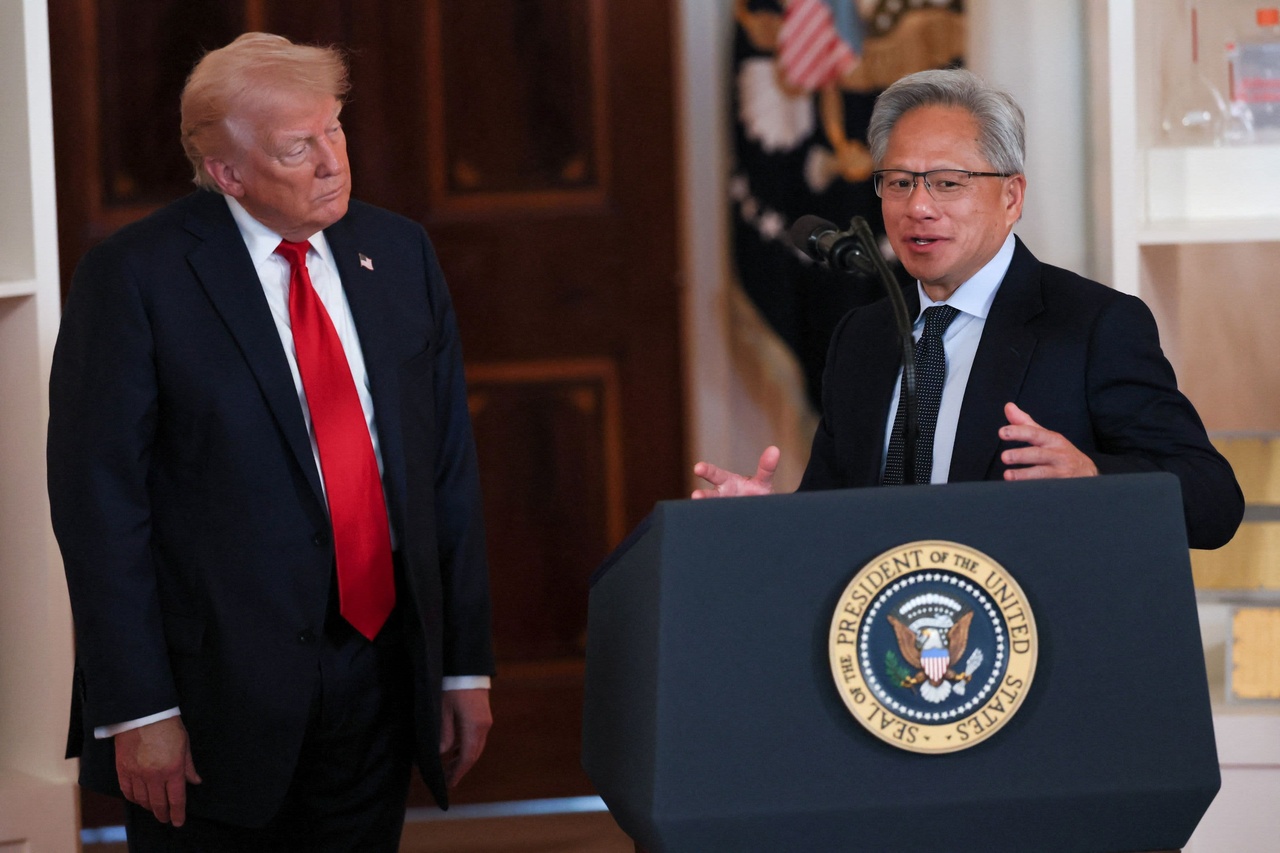
What can you say except:
https://www.youtube.com/watch?v=r5sTTlph2Vk
ASML – A Monopoly for a Bargain
1) Executive Summary
ASML is the world’s only supplier of extreme ultraviolet lithography (EUVL) systems. This technology is essential for the production of the most advanced chips worldwide.
The company’s monopolistic position in the semiconductor industry provides considerable pricing power and a large moat, forcing customers to buy from a single source: ASML.
Its moat also does not show any sign of fading and is underpinned by decades of R&D, control over the supply chain, and global dependence.
Despite being at the forefront of the AI boom, ASML trades at a forward P/E ratio of ~25-26, well below its average, offering a rare opportunity to own a dominant, critical infrastructure provider, without a massive price tag.
2) Investment Thesis
ASML operates as a monopoly, plain and simple. The company is the exclusive supplier of EUVL machines essential for powering the AI revolution. ASML controls 100% of the global market for these machines – not a single known competitor. Additionally, ASML owns almost the entire value chain for these machines – it acquired multiple suppliers to fortify its position.
Furthermore, the company is not just reliant on selling EUVL machines, as service revenue is responsible for roughly 27% of all revenue. ASML is more than a simple manufacturer of some advanced lithography tools, it is a fully integrated high-tech company, laying the foundation for an AI-dominated future.
Subsequently, as these machines advance, chip foundries like TSMC and Intel have no other choice than purchasing newer models, in order to maintain their position. ASML is in a unique spot to set the pace of innovation for global foundries, which is powering the AI boom and data center expansion.
Finally, ASML illustrates a classic case of market mispricing. Investors undervalue the monopolistic position of the company and rather tend to focus on short-term trade headwinds. It would also be wise to consider that the force creating the tariff concerns, would never allow the U.S. to fall behind in the AI race, and there is no company more crucial to facilitating innovation in that regard than ASML.
This represents a (near) perfect opportunity to add a monopoly in the arguably fastest-growing industry worldwide, to your portfolio at a forward P/E ratio around 25, a multiple-year-low valuation.
3) Growth Drivers
While the AI race is fully underway now, underappreciated innovators like ASML drive this immense growth. Global demand for WFE (Wafer Fab Equipment) is rising rapidly, which is reflected by ASML’s healthy growth (Revenue CAGR ~15%, 2021-2025).
The scaling of AI models moves demand for WFE to more advanced machines and is likely to lead to a rise in total sold products (at a higher price point), as well as increased service revenue.
On top of the secular growth prospects, cyclical rebuild cycles, as happening for DRAM and NAND memory chip suppliers, play a major role in ASML’s global expansion. Companies like Micron need to level up their machines regularly to meet rising cloud demand.
Similarly, major chip foundries are constantly innovating, which can only be facilitated through advanced systems, delivered by ASML. In order to keep a competitive edge over competitors, global players like TSMC, will always buy the hottest and newest lithography machines, which benefits the only player in this market: ASML.
With rising CapEx, the company is in a prime spot to capitalise, which makes future growth estimates seem conservative.
4) Competitive Position
ASML’s technology is deeply embedded in the operations of the largest chip makers worldwide. Leading global foundries like Samsung, TSMC and Intel account for the lion’s share of ASML’s EUVL sales, which makes them heavily reliant on ASML’s maintenance services as well, boosting recurring, high-margin revenue generation.
To understand why ASML is in such a monopolistic position and has widened its moat over time, it is important to consider a few factors that prevent competitors from entering the market successfully.
A first technological barrier for other companies is the R&D intensity of the business: ASML has invested billions in EUVL for decades, apart from the millions of hours of development that were spent before the first commercial shipment.
Another substantial advantage for ASML is its control of the supply chain: the company has exclusive partnerships with Zeiss (optics) and Cyber (light sources), for instance, through partial ownership or full integration, ensuring value chain quality and safety.
Also noteworthy is the relationship ASML has built with customers over years of successful integration of its machines into global chip production facilities. Competitors would have to outshine ASML’s reputation or seriously undercut prices to lure foundries away.
5) Recent Financials
Highlights of the most recent Q2 2025 report:
· Total net sales: €7.7 billion (upper bound of guidance)
· System sales: €5.6 billion, with Installed Base Management hitting €2.1 billion (strong recurring revenue)
· ~54% gross margin and 35% operating margin (beating guidance)
· Net bookings: €5.54 billion, with ~€2.3 billion from EUV systems
· Announced dividend of €1.60/share and major buybacks of €1.4 billion
While there are many positive takeaways, from the results and the call, like strong execution (sales and margins beat expectations), high bookings in EUV signalling continued demand, recurring revenue strength and a healthy buyback program, not everything was great.
Most notably, the refusal of management to confirm growth for 2026, due to macroeconomic and geopolitical uncertainties and a disappointing sales guidance for Q3.
However, the positives seem to outshine the negatives on these results and geopolitical uncertainties tend to resolve fairly quickly in this day and age, considering the high deal flow announced by the White House, which makes me optimistic for a brighter guidance in the next earnings report.
6) Valuation
As mentioned above multiple times, ASML is cheap at current levels, considering its position. Here are some key metrics to underpin that assumption:
· Forward P/E: ~25/26 (avg. of ~34 in the last 5 years)
o Considerations: EPS consensus seems rather conservative, due to highlighted geopolitical tension during the last call
· Forward P/FCF: ~30 (falling rapidly YoY due to strong growth, expected to continue)
· Gross Margin: ~53% (at ATHs, up from 45% in 2019)
· Operating Margin: ~35% (up from 24% in 2019)
· FCF Yield: ~4% (avg. ~3.3% in the last 5 years)
Multiple factors including the company’s moat, and future potential, a multi-year low valuation combined with expanding margins and free cash flow yield, make the stock a compelling buy right now.
7) Risks
Trade restrictions form one of the key problems ASML faces, though it might not be as bad as it looks. Much of the uncertainty around possible tariffs has already vanished, especially after the U.S.–EU trade deal and President Trump’s confirmation that companies investing in America will be exempt from the immense tariff rates (>100% and rising) imposed on the semiconductor industry.
Another possibly considerable risk is innovations of Chinese competitors happening under the radar. Nobody can estimate how far China has already advanced and how soon they could launch alternative solutions to ASML’s products.
However, there is a geopolitical lifeline, even in the unlikely case that Chinese newcomers could overtake ASML: The U.S., especially under the current administration, and in part Europe aim to be as independent from China as possible, reducing the risk of U.S. foundries rotating their sales to a possible Chinese competitor. And even if no restrictions were imposed from the Western side, there is no incentive for China, an autocratic regime, to allow its tech to aid the U.S.’ advances in the AI race.
There is no company that does not face any risks, though ASML is in a relatively strong position to alleviate core uncertainties, especially those within their control, through innovation and strong management execution.
8) Catalysts & Timeline
In the near future it is possible that geopolitical pressures can keep the stock down, but it is critical to emphasize that these issues are temporary. The AI boom is fully underway and the chip market is booming, further solidifying ASML’s importance globally.
Mid to long-term the outlook is incredibly bright – the stock market usually does not misprice excellent companies forever and while Nvidia and AMD are getting most of the spotlight, ASML is compounding in the background. Macro headwinds are likely to fade over the next quarters and the stock is poised for a rebound.
9) Conclusion
ASML sits at the intersection of demand (AI, advanced logic, memory) and impresses with a near-insurmountable technological moat as the sole EUVL supplier. The Q2 2025 report demonstrates robust demand and healthy, expanding margins, and while management’s cautious tone might signal uncertainty, it is more likely they try to set low expectations, in order to beat later. This should not unsettle long-term investors, who believe in the AI revolution, resulting CapEx, and strong fundamentals.
Personally, I think the downsides are limited and, to a great extent, already priced in. It is vital to emphasize again that a Forward P/E ratio of 25 is certainly not expensive for a sole contender in their respective field, especially one so crucial for the future.
$ASML (-3,69 %)
$ASML (-3,86 %)
$TSM (-4,23 %)
$2330
$INTC (-4,8 %)
$005930
$NVDA (-3,26 %)
$AMD (-4,68 %)
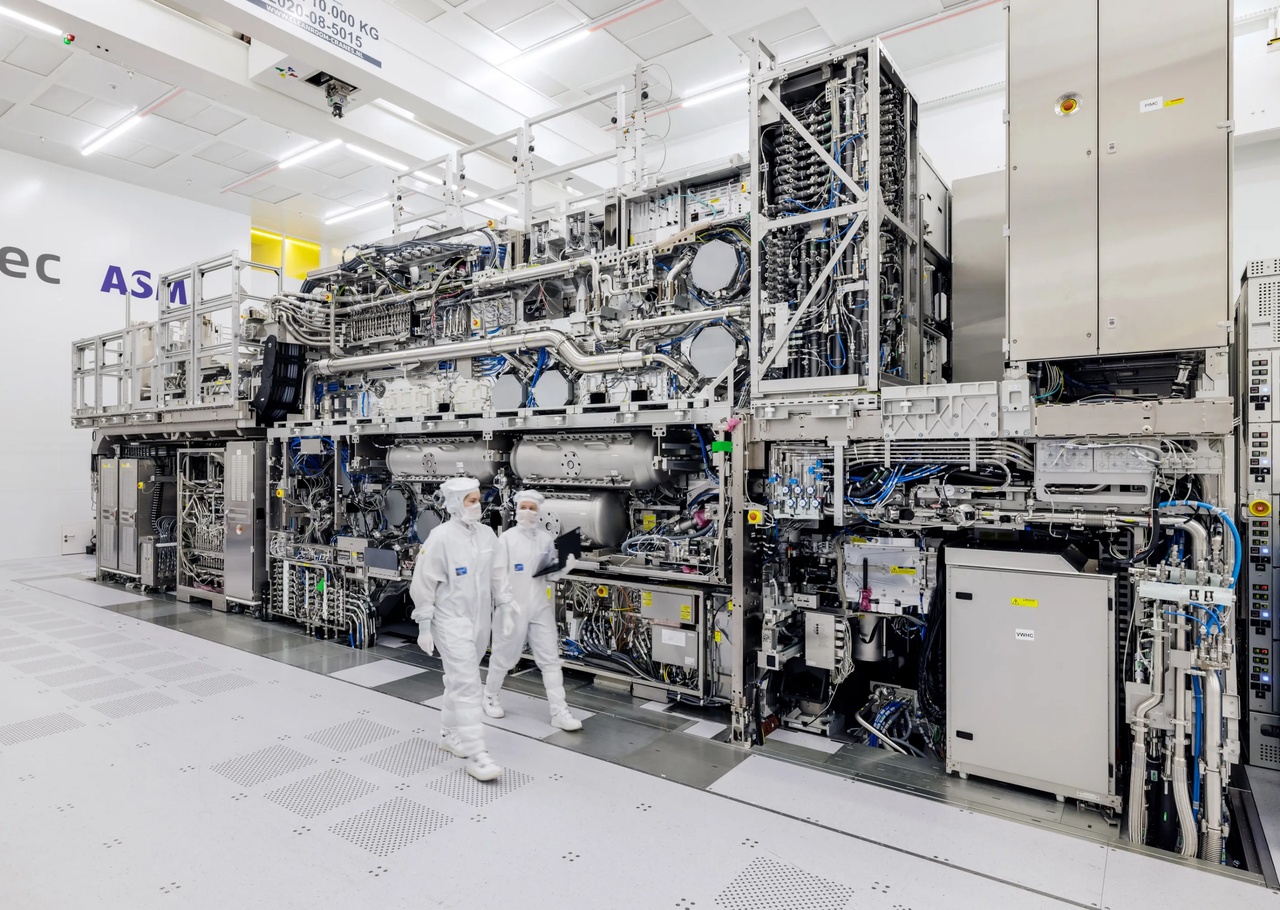
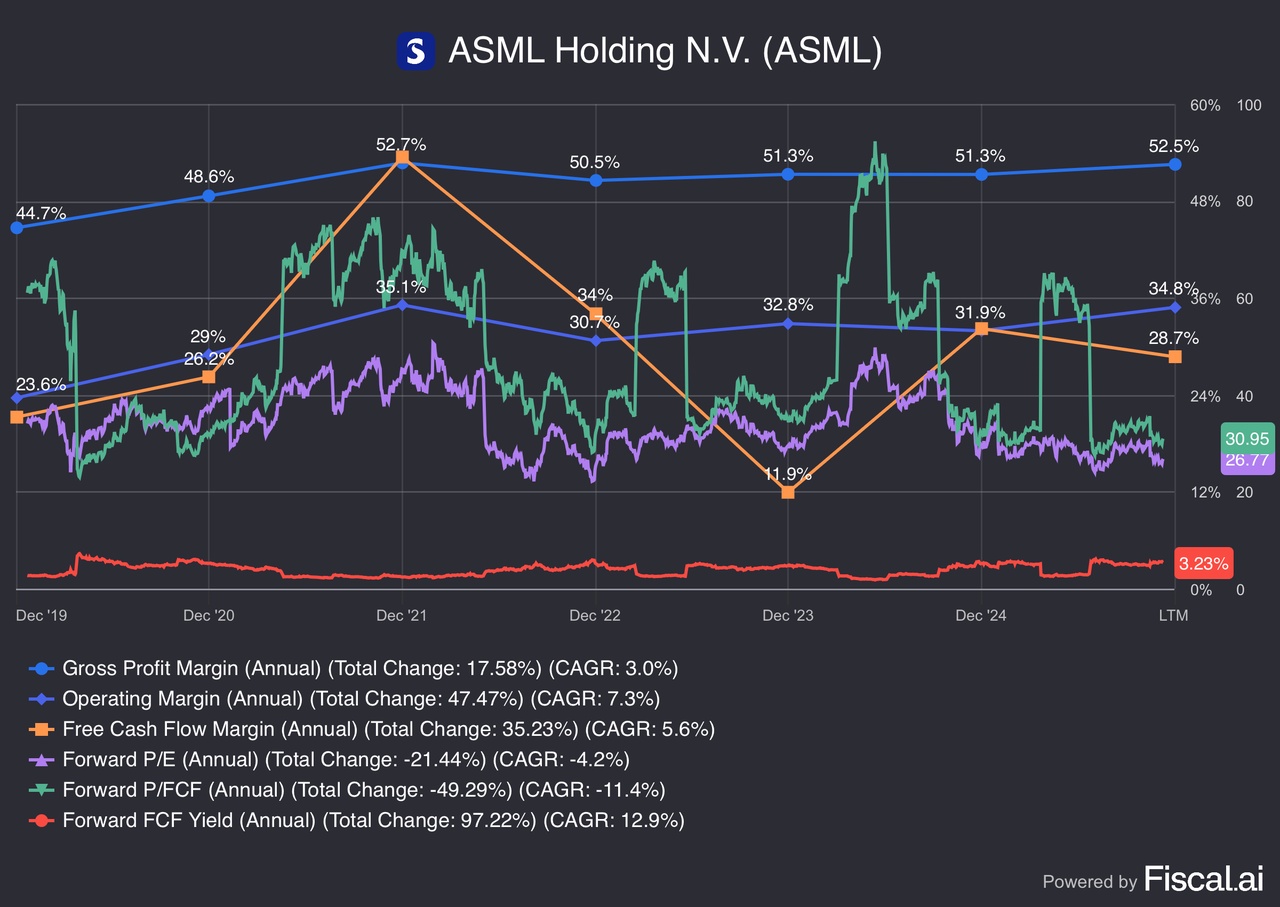
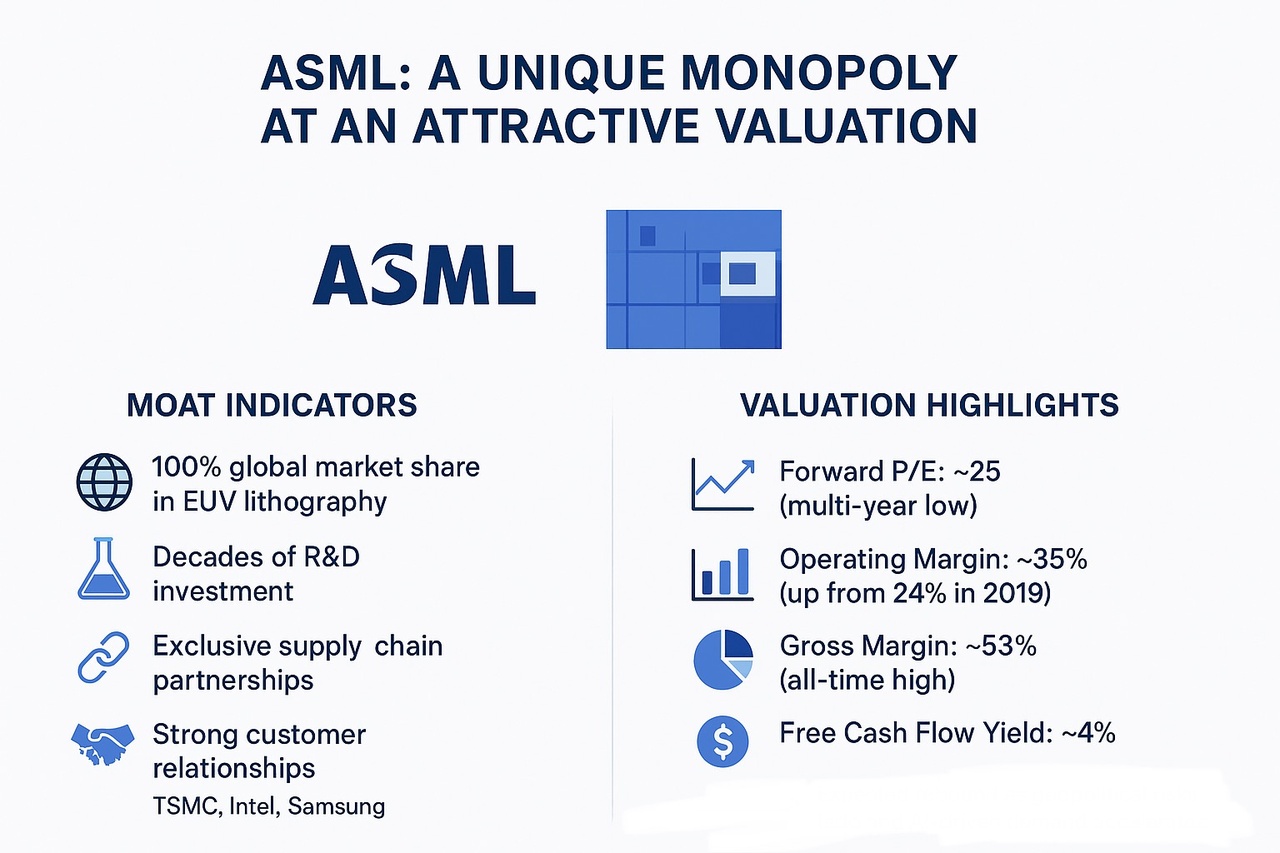
+ 5
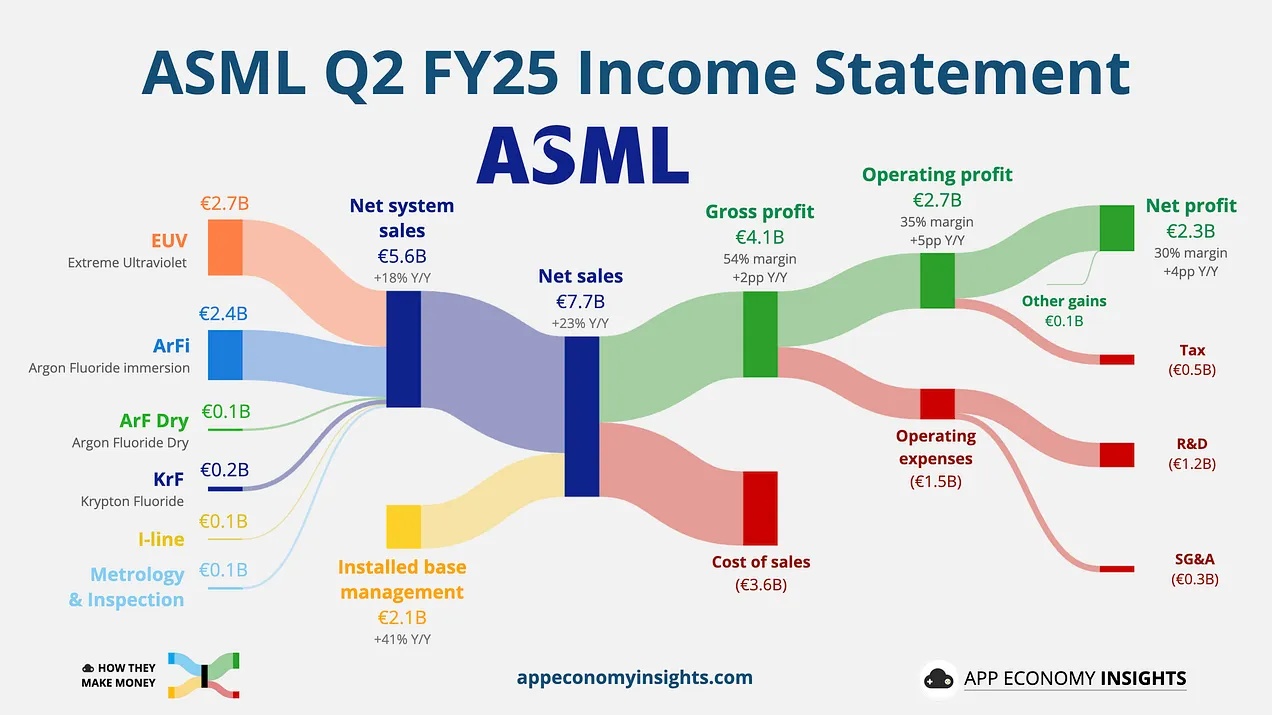
Titres populaires
Meilleurs créateurs cette semaine














